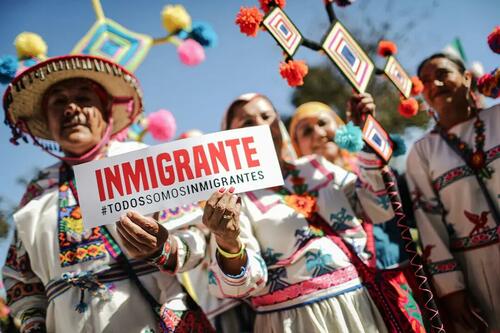Immigration And The Economy: A Complicated Picture
Authored by Petr Svab via THe Epoch Times (emphasis ours),
Immigration has become an increasingly prominent political issue, heightened by the sharp increase in people coming into the country across the southern border.

While studies show it’s good for the economy overall to let more people into the country, they also show that some Americans benefit more than others, and some end up being worse off. It also matters who comes in and how. Poorly regulated immigration contributes to problems not readily apparent when looking from purely economic point of view, some experts argue.
Even many who pride themselves as pro-immigrant have reevaluated their attitudes in light of the border situation that’s now being felt in communities across the country. As recently as June last year, 40 percent of Democrats favored increasing immigration, Gallup reported. This February, the number sank to 27 percent, based on AP/NORK poll.
Republicans or those who lean Republican overwhelmingly see illegal immigration as a “crisis” or “major problem,” according to Pew Research. Majority of them would also prefer less immigration overall, according to Gallup.
Who Benefits?
A growing body of research shows that immigration boosts the economy in the long term.
An upcoming paper by Prof. Tarek Hassan, a Boston University economist, estimates that an influx of 12,000 new immigrants into an average U.S. county boosts its per capita patent filing by native population by 30 percent and the average wage of natives by 5 percent—all within five years. The wage effect would then perhaps double over the next few decades before gradually fading away.
The dynamic behind the results, Mr. Hassan told The Epoch Times, could be described as a “battle between two forces.”
“When more migrants arrive … they should be driving down wages, because more workers should mean lower wages for everyone,” he said.
“But at the same time, we also believe that economic growth comes from just more people being able to sit down and think about ideas.”
The paper demonstrates that the latter effect “wins out,” he said. The theory is that the production and consumption of the new immigrants makes for a larger economy which is then able to support more higher paid jobs.
Yet the study results, shared with The Epoch Times, indicate it’s the highly educated immigrants who bring the bulk of the benefits. Low-educated immigration caused negative effects on both innovation and education, the results showed, but neither figure was statistically significant—the margin of error was too large.
“It is true that more educated immigrants have more positive effects,” Mr. Hassan acknowledged.
That’s where the distinction between legal and illegal immigration comes into play.
While immigrants overall are almost as educated as the native population—36 percent has a Bachelor’s or higher degree—among illegal immigrants the share is just 18 percent, based on estimates by the Migration Policy Institute.
Americans are also much more concerned about illegal, rather than legal, immigration, according to a March AP/NORK poll.
Mr. Hassan’s paper concluded that highly educated Americans benefited the most from immigrant inflow. Those with at least 5 years of college had their wages go up much more than those with 4 years of college. The wages of those with less education barely budged. Those lacking a high school diploma had their wages slightly drop, though again, the figure wasn’t statistically significant.
Prof. Giovanni Peri, an economist at University of California, Davis, used a different method to discern the effects of immigration on wages and employment of native workers. His results seem to clash in part with Mr. Hassan’s.
In an April paper, coauthored with Alessandro Caiumi, Mr. Peri concluded that immigration resulted in somewhat higher wages and higher employment for less educated native workers, but had virtually no effect on the more educated ones in the 2000-2019 period.
New immigrants did caused wages to go down for some people—other immigrants, he found—but only those with high school or higher education.
Mr. Peri noted that low-education immigrants often come illegally and work either off the books or ask for asylum, which allows them to get a work permit while their case is pending.
“The problem is that the large majority of these people will not get asylum,” he told The Epoch Times.
Indeed, those crossing the southern border often flee crime in their home county or seek better employment, neither of which are grounds for asylum, which is reserved for people facing persecution.
Based on his results, Mr. Peri proposed opening a way for low-education immigrants to come to the country legally to fill jobs often picked up by illegal immigrants in restaurants, hotels, on farms, and as aides for the elderly.
“We would be able much more to track and know what’s going on with them. It would be much more orderly,” he said.
Mr. Peri’s paper did find some negative effect of immigration on native employment, but only among less experienced workers with less than high school.
Both Mr. Hassan and Mr. Peri also noted that their research looks at average immigration effects.
“There are many microeconomic studies that have documented wages going up or down for specific groups in specific places at a specific point in time,” Mr. Hassan said.
His argument is that when the effects are averaged, immigration helps the economy, even on a local level.
Fiscal Impact
Whatever the economic benefits of immigration, it should be balanced against how much it costs the taxpayer, some experts have argued. Illegal immigration is particularly expensive because it burdens the immigration enforcement apparatus.
“In a country where you’re trying to provide the procedural process associated with Western civilization, our constitutional norms, a fundamental fairness and a quasi-judicial proceeding, where you have hearing after hearing on removal proceedings, it’s very expensive to try to get someone out of the country,” said Daniel Stein, president of the Federation for American Immigration Reform (FAIR), which advocates for significantly lower immigration.
FAIR has attempted to calculate the fiscal cost of illegal immigration, including immigration enforcement, law enforcement, welfare, medical care, and education for children. Last year, the annual cost reached $163 billion, up from $116 billion in 2017, it reported, though acknowledging limitations of the estimates due to lack of data.
Many illegal immigrants also work off the books so they don’t pay income taxes.
Even if they do pay taxes, however, on average they still end up being a fiscal drain simply on account of not making enough money, according to Steven Camarota, director of research at the Center for Immigration Studies (CIS), which also advocates for lower immigration.
“U.S.-born people and legal immigrants who make $15, $18, $20 an hour are typically a fiscal drain too,” he told The Epoch Times.
Read more here…
Tyler Durden
Tue, 06/25/2024 – 07:20
via ZeroHedge News https://ift.tt/1tGBl6u Tyler Durden


